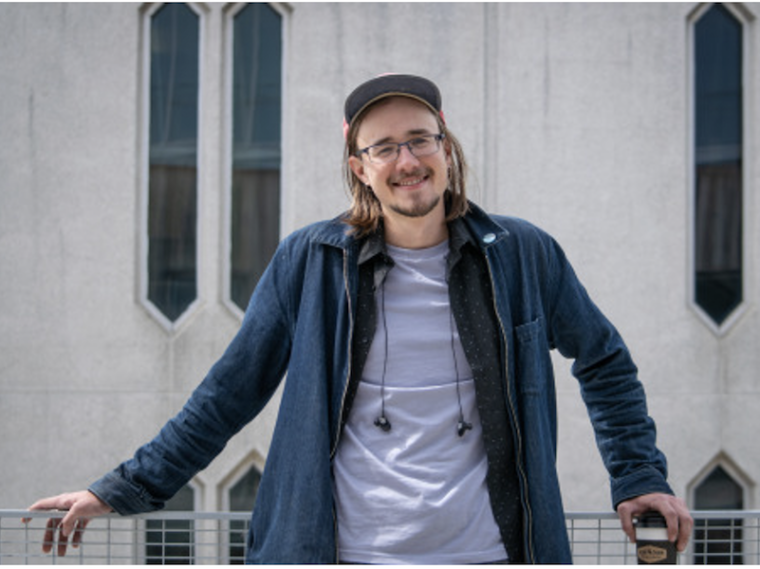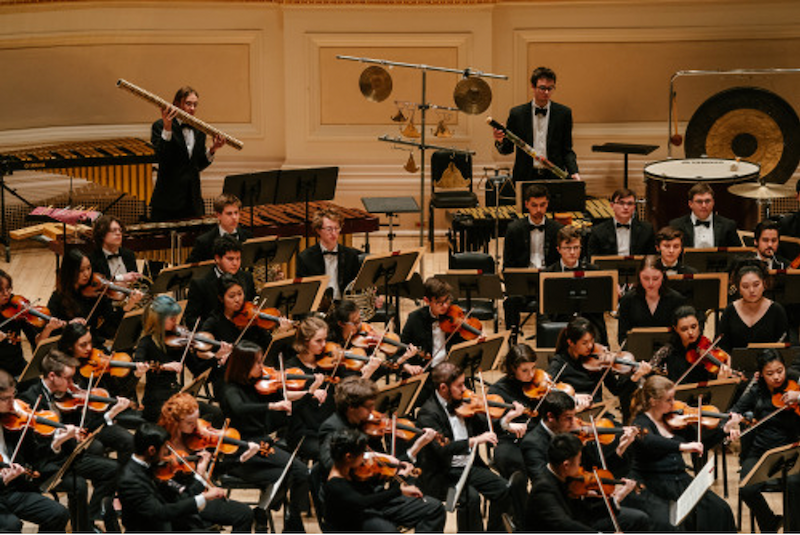In the Practice Room with Percussionist and Fulbrighter Carson Fratus
April 8, 2019
Conservatory Communications Staff

After earning two Oberlin degrees, he will pursue his love of South Indian music.
In March 2019, the J. William Fulbright Foreign Scholarship Board awarded Carson Fratus BM ’17, AD ’19 a scholarship to India. When he wraps up his artist diploma at Oberlin this semester, the musician from Knoxville, Tennessee, will embark on a year of exploring the traditional music of South India.
How did music come into your life? What was your path to studying percussion at Oberlin?
I started with piano and voice from a very young age and grew up playing and singing in church. I didn’t start playing percussion until middle school and didn’t start to formally study percussion until my junior year of high school. The transition between the two was very slow, but I eventually realized that drums were my calling.
What have been some of your best experiences in Oberlin?

The performance opportunities I’ve had through the conservatory ensembles are invaluable, but a lot of my favorite musical experiences have come from collaborations outside of my coursework. My studies with percussionist Jamey Haddad and trombonist/composer Jay Ashby through Oberlin’s Performance and Improvisation program have impacted me greatly. As I began to study traditional music from around the world—as well as traditional American music—more and more performance opportunities began to appear as I branched out into new styles and avenues of playing.
How do you plan to spend your time in India? What will your project look like?
I will be studying South Indian classical music, called Carnatic music. I will be working with revered gurus, learning to play an ancient and beautiful drum called a mridangam. I will also be teaching kids in public schools how to read Western notation, as well as giving lessons on drum set and frame drum.
You’ve posted some videos of yourself performing Carnatic music, specifically solkattu, where you chant rhythms on syllables while tapping out the meter with your hands. How did you discover this art form?
I first began to study konnakol with Jamey Haddad through his internalizing rhythms class, which can be taken by any student at Oberlin. I recommend it for all types of musicians. Jamey Haddad received a Fulbright to India many years ago for the same study, so I am essentially following in his footsteps.
You participated in Jamey Haddad’s winter term trip to India a few years ago. What were some of the musical highlights of that experience?
Yes, that trip to India in 2017 was life changing for me. We spent two weeks with master musicians who did their best to give us a taste of a tradition that is as deep as it is ancient. This lit the fire for me, and I jumped into everything that was presented to us, really trying to make the most out of the experience. I’d say one of the best parts of the trip was performing for an audience of almost a thousand kids on a big stage. We were playing arrangements of jazz standards as well as just grooving and playing to the crowd. The audience was so responsive and energetic, I had never felt that kind of vibe on a stage before. Unreal.
You may also like…
Josh Nolan Named Vice President, General Counsel, and Secretary at Oberlin
Distinguished attorney brings extensive experience in higher education law.
Learning by Teaching: Oberlin Students Share Global Music with Young Learners
College and Conservatory students in PACE 103 prepare local children for an immersive community concert at Oberlin.
Nuiko Wadden ’02 Joins Oberlin Conservatory Faculty as Assistant Professor of Harp
The versatile musician brings extensive opera, orchestral, and contemporary music experience to her role


